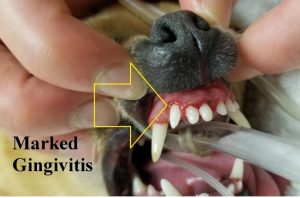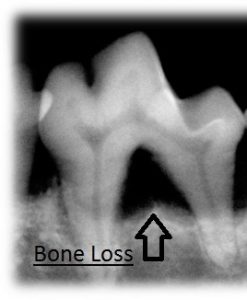If your pet’s veterinarian has identified dental disease in a prior examination or problematic teeth during their dental examination under general anesthesia, they may request radiographs be taken to help better assess your pet’s oral health. A technician will take digital dental radiographs so your veterinarian can visualize what is occurring at the level of the roots of the teeth. A tooth may look normal on the surface but radiographs may reveal issues that are not visually apparent otherwise. Outlined below are some examples of instances where dental radiographs are beneficial.
Gingivitis
Gingivitis is a form of periodontal disease that leads to inflammation and redness of the gums. Dental radiographs will reveal to the veterinarian if the gingivitis is due to a problematic tooth that needs to be extracted or simply due to a buildup of tartar on the surface of the tooth. Also, if a tooth appears to be missing but, the gingiva is red and inflamed, radiographs should still be taken. Radiographs will ensure that the tooth is truly missing and/or no portion of the tooth remains if it has previously been extracted. Radiographs would also rule out impacted teeth which can lead to dangerous cysts and even jaw fracture if left untreated.

Extraction of Roots
In cases where teeth need to be extracted, it is beneficial to take dental radiographs to visualize the roots of the teeth. Having a clear visual of the roots will assist the veterinarian when they are extracting the teeth. Being able to compare the extracted tooth to the dental radiograph will further ensure that the entirety of the tooth has been extracted.

Tooth Resorption
Tooth resorption affects 20-60% of all cats, its cause is unknown and it is very painful. Tooth resorption occurs when cells called odontoclasts destroy the roots by resorbing the enamel and as it progresses, it destroys more of the tooth. Dental radiographs are important with tooth resorption in two ways. Radiographs may identify the resorbing roots of a tooth that has no visible evidence of resorption of the crown (the part of the tooth that can be seen visually in the mouth). Also, root resorption may be so advanced that the roots of the tooth do not need to be extracted. Instead, a crown amputation may be performed. Crown amputations are performed by separating the crown from the roots, smoothing the rough surface of the roots and suturing the gingiva closed. This procedure eliminates further pain for the patient.
Tooth Mobility and Advanced Periodontal Disease
If the patient has mobile teeth, dental radiographs should be taken to determine the cause of mobility and the extent of bone loss. Untreated bacteria-harbouring plaque and tartar will eventually lead to advanced periodontal disease and bone loss. The roots of teeth with 50% bone loss or greater require extraction. Radiographs may also reveal the presence of an abscess surrounding the roots which will require post-operative antibiotics. In the event that an extraction is required, radiographs will also allow the veterinarian to quote clients more accurately with respect to the amount of work required to extract the diseased tooth.


Please give us a call if you would like to schedule an appointment for your pet’s FREE dental examination!

